
Wyoming is a state in the Mountain West subregion of the Western United States. It is bordered by Montana to the north and northwest, South Dakota and Nebraska to the east, Idaho to the west, Utah to the southwest, and Colorado to the south. With a population of 576,851 in the 2020 United States census, Wyoming is the least populous state despite being the 10th largest by area, with the second-lowest population density after Alaska. The state capital and most populous city is Cheyenne, which had an estimated population of 63,957 in 2018.
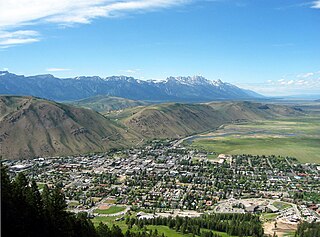
Jackson is a town in Teton County, Wyoming, United States. The population was 10,760 at the 2020 census, up from 9,577 in 2010. It is the largest town in Teton County and its county seat. Jackson is the principal town of the Jackson, WY-ID Micropolitan Statistical Area, which includes Teton County in Wyoming and Teton County in Idaho. The town, often mistakenly called Jackson Hole, derives its name from the valley in which it is located. Jackson is a popular tourist destination due to its proximity to the ski resorts Jackson Hole Mountain, Snow King Mountain, and Grand Targhee, as well as Grand Teton National Park and Yellowstone National Park.
The National Fish Hatchery System (NFHS) was established by the U.S. Congress in 1871 through the creation of a U.S. Commissioner for Fish and Fisheries. This system of fish hatcheries is now administered by the Fisheries Program of the U.S. Fish and Wildlife Service (Service), an agency within the United States Department of the Interior.

Jackson Hole is a valley between the Gros Ventre and Teton mountain ranges in the U.S. state of Wyoming, near the border with Idaho, in Teton County, one of the richest counties in the United States. The term "hole" was used by early trappers, or mountain men, as a term for a large mountain valley. These low-lying valleys, surrounded by mountains and containing rivers and streams, are good habitat for beavers and other fur-bearing animals. Jackson Hole is 55 miles (89 km) long by 6-to-13 miles (10-to-21 km) wide and is a graben valley with an average elevation of 6,800 ft, its lowest point being near the southern park boundary at 6,350 ft.

The cutthroat trout(Oncorhynchus clarkii) is a fish species of the family Salmonidae native to cold-water tributaries of the Pacific Ocean, Rocky Mountains, and Great Basin in North America. As a member of the genus Oncorhynchus, it is one of the Pacific trout, a group that includes the widely distributed rainbow trout. Cutthroat trout are popular gamefish, especially among anglers who enjoy fly fishing. The common name "cutthroat" refers to the distinctive red coloration on the underside of the lower jaw. The specific name clarkii was given to honor explorer William Clark, coleader of the Lewis and Clark Expedition.
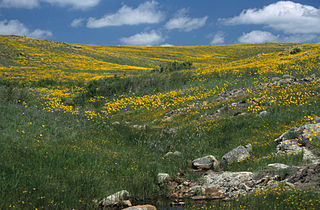
Wichita Mountains Wildlife Refuge, located in southwestern Oklahoma near Lawton, has protected unique wildlife habitats since 1901 and is the oldest managed wildlife facility in the United States Fish and Wildlife Service system. The refuge's location in the geologically unique Wichita Mountains and its areas of undisturbed mixed grass prairie make it an important conservation area. The Wichita Mountains are approximately 500 million years old. Measuring about 59,020 acres (238.8 km2), the refuge hosts a great diversity of species: 806 plant species, 240 species of birds, 36 fish, and 64 reptiles and amphibians are present.

The National Elk Refuge is a Wildlife Refuge located in Jackson Hole in the U.S. state of Wyoming. It was created in 1912 to protect habitat and provide sanctuary for one of the largest elk herds. With a total of 24,700 acres (10,000 ha), the refuge borders the town of Jackson, Wyoming on the southwest, Bridger-Teton National Forest on the east and Grand Teton National Park on the north. It is home to an average of 7,500 elk each winter. The refuge is managed by the U.S. Fish and Wildlife Service, an agency of the U.S. Department of the Interior.

The Metolius River is a tributary of the Deschutes River in Central Oregon, United States, near the city of Sisters. The river flows north from springs near Black Butte, then turns sharply east, descending through a series of gorges before ending in the western end of the lake. The unincorporated community of Camp Sherman lies astride the southern end of the river. The name of the river comes from the Warm Springs or Sahaptin word mitula, meaning white salmon and referring to a light colored Chinook salmon and not a whitefish.
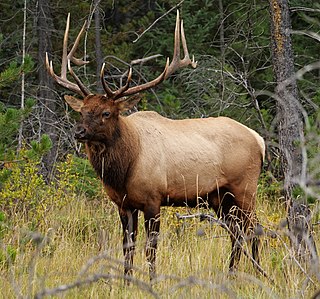
The elk, or wapiti, is one of the largest species within the deer family, Cervidae, and one of the largest terrestrial mammals in its native range of North America and Central and East Asia. The word "elk" originally referred to the European variety of the moose, Alces alces, but was transferred to Cervus canadensis by North American colonists. The name "wapiti", derived from a Shawnee and Cree word meaning "white rump", is also used for C. canadensis.

The National Museum of Wildlife Art (NMWA) is a museum located in Jackson Hole, Wyoming, United States that preserves and exhibits wildlife art. The 51,000 square foot building with its Idaho quartzite façade was inspired by the ruins of Slains Castle in Aberdeenshire, Scotland and echoes the hillside behind the facility. Located on a bluff called East Gros Ventre Butte in the midst of a real wildlife habitat, the institution overlooks the National Elk Refuge and is situated 2.5 miles north of the town of Jackson. The core of the collections reflects traditional and contemporary realism. The museum's centerpiece is a collection of works by Carl Rungius (1869-1959) and Bob Kuhn (1920-2007). In addition to 14 galleries, the museum has a sculpture trail, museum shop, restaurant, children's discovery gallery, and library. More than 80,000 people visit every year, and over 10,000 children visit the museum each year, often as part of their school curricula. The Museum is a nonprofit.
The Neosho National Fish Hatchery is the oldest federal fish hatchery in operation today. It is one of 69 fish hatcheries operated by the US Fish and Wildlife Service. It was established in 1888.

The Miller Cabin complex consists of three buildings that were the residence of Robert A. Miller, the first superintendent of Teton National Monument. A house, a barn and a cabin built by the U.S. Forest Service are included. The property was eventually transferred to the U.S. Fish and Wildlife Service in what became the National Elk Refuge. The buildings are a component of the closely related Grace and Robert Miller Ranch.

The White River National Fish Hatchery is a U.S. Fish and Wildlife Service coldwater fish production facility located near Bethel, Vermont. Hatchery staff works to support both the Connecticut River Atlantic Salmon Restoration Program and the Lower Great Lakes Lake Trout Restoration Program. The White River National Fish Hatchery is one of four offices in the Western New England Complex.

The ecology of the Rocky Mountains is diverse due to the effects of a variety of environmental factors. The Rocky Mountains are the major mountain range in western North America, running from the far north of British Columbia in Canada to New Mexico in the southwestern United States, climbing from the Great Plains at or below 1,800 feet (550 m) to peaks of over 14,000 feet (4,300 m). Temperature and rainfall varies greatly also and thus the Rockies are home to a mixture of habitats including the alpine, subalpine and boreal habitats of the Northern Rocky Mountains in British Columbia and Alberta, the coniferous forests of Montana and Idaho, the wetlands and prairie where the Rockies meet the plains, a different mix of conifers on the Yellowstone Plateau in Wyoming and in the high Rockies of Colorado and New Mexico, and finally the alpine tundra of the highest elevations.

The South Central Rockies forests is a temperate coniferous forest ecoregion of the United States located mainly in Wyoming, Idaho, and Montana. It has a considerably drier climate than the North Central Rockies forest.
The Webb Canyon Trail is a 9.9-mile (15.9 km) long hiking trail in the far northern region of Grand Teton National Park in the U.S. state of Wyoming. The trail begins near the National Park Service backcountry patrol cabin near Wilcox Point on Jackson Lake. Located in the remote northern backcountry of Grand Teton National Park, the trail is not connected to maintained trails in the southern part of the park and must be accessed from the Glade Creek trailhead in the John D. Rockefeller, Jr. Memorial Parkway. From Glade Creek, it is a 7.5 mi (12.1 km) hike to the patrol cabin and the beginning of the Webb Canyon Trail. The trail follows Moose Creek west and after several miles, is flanked by both Owl Peak and Elk Mountain to the north and several unnamed peaks nearing 11,000 ft (3,400 m) to the south. At Moose Basin Divide the trail meets the Owl Creek Trail.
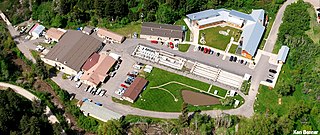
The Bozeman National Fish Hatchery, now known as Bozeman Fish Technology Center, is located about 4 miles (6.4 km) northeast of Bozeman, Montana, at the entrance to Bridger Canyon. There is also a National Fish Health Center on the southwest side of Bozeman, near Montana State University, about 7 miles (11 km) away from the Fish Technology Center. Fish Technology Centers work with a wide variety of public and private partners to improve and conserve aquatic resources. Both the Fish Technology Center and the Fish Health Center are part of the National Fish Hatchery System, operated by the United States Fish and Wildlife Service. There are seven Fish Technology Centers and nine Fish Health Centers in the United States. The Bozeman hatchery is the fourth oldest National Fish Hatchery. The hatchery was named to the National Register of Historic Places on January 6, 1983.
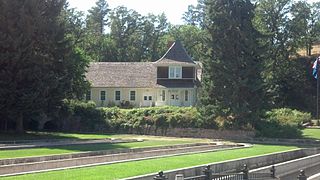
The D.C. Booth Historic National Fish Hatchery and Archives, also known as the Spearfish Fisheries Center or Spearfish Fisheries Complex and formerly known as the Spearfish National Fish Hatchery, is one of 70 fish hatcheries that were opened by the U.S. Fish and Wildlife Service as part of the National Fish Hatchery System. The hatchery was established near Spearfish, South Dakota in 1896, with the purpose of introducing and establishing populations of trout in the Black Hills of South Dakota and Wyoming. It is one of the oldest fish hatcheries in the United States and is the second-oldest in the American West. The hatchery spawns and releases about 20,000 to 30,000 rainbow trout each year. The hatchery doubles as a fisheries archive with the purpose of preserving records and early historical artifacts. It is listed on the National Register of Historic Places.

Saratoga National Fish Hatchery is part of the National Fish Hatchery System operated by the United States Fish and Wildlife Service. It is located northeast of Saratoga, Wyoming and, along with the Jackson National Fish Hatchery, is one of two National fish hatcheries operating in Wyoming. Saratoga NHF is primarily a broodstock hatchery; it maintains several healthy adults to produce sperm and eggs and distributes fertilized eggs to production hatcheries throughout the country to be hatched and grown to stockable sizes. It is also one of several organizations to establish a program for breeding Wyoming toads.
Elected officials in Jackson, Wyoming, have added a proposal to the November 2019 ballot for a special-purpose excise tax to fund wildlife crossings. If the ballot initiative passes, it will fund proposed wildlife crossings in accordance with the Teton County Wildlife Crossing Master Plan.
















